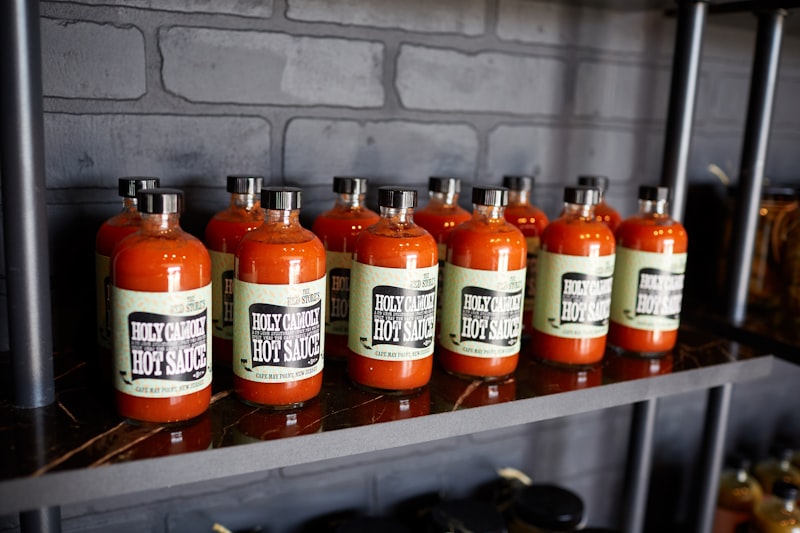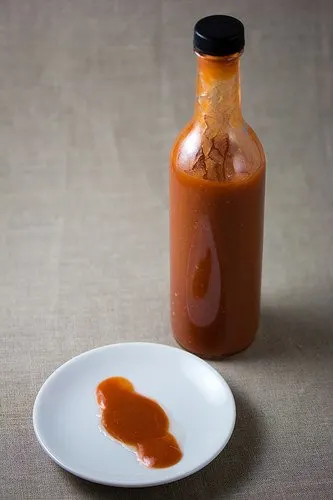In a nutshell:
- Shelf life: Unopened hot sauce can last 2-5 years; opened, 6-12 months.
- Spoilage: Signs include mold, off smell, or separation of ingredients.
- Storage: Cool, dry place for unopened bottles; refrigerator for opened.
Calling all heat enthusiasts! If you’re a fan of spicy condiments, you’ve come to the right place.
In this article, we’ll dive into the world of hot sauce, exploring its shelf life, spoilage, and proper storage methods. You’ll learn about the factors affecting your favorite fiery condiment’s longevity and how to maximize its freshness for the best flavor experience.
So, whether you’re a casual hot sauce user or a die-hard aficionado, stick around to make sure your spicy delights last as long as they should and taste just as great as the day you bought them.
Let’s spice things up!
How Long Does Hot Sauce Last?
Unopened hot sauce can last for 3-5 years, while opened hot sauce typically has a shelf life of 6-12 months. Storing it properly can help maintain its taste and quality.
Just like vinegar, BBQ sauce, and Worcestershire sauce, hot sauce’s longevity comes from its acidic nature and preservative ingredients.
Unopened Hot Sauce
An unopened hot sauce bottle has a long shelf life of 3-5 years, indicated by the “expiration date” on the label. But thanks to its acidic nature and preservative ingredients, it typically stays safe way beyond the printed date.
Like vinegar and mustard, the high acidity helps prevent bacterial growth, allowing it to last longer.
The key factors in hot sauce’s lengthy shelf life include its high vinegar content, which acts as a natural preservative, and the capsaicin found in chili peppers, which has antimicrobial properties.
To maximize the shelf life of unopened hot sauce, store it in a cool, dry, and dark place, like a pantry or cupboard. This will help preserve its flavor and prevent it from deteriorating too quickly.

Opened Hot Sauce
Once opened, most hot sauces retain quality for 6 to 12 months, but refrigerating them helps prolong the storage time even further. As long as the quality of the sauce is okay and it doesn’t show any spoilage signs, it’s most likely okay to use.
Its longevity is similar to other opened condiments, such as soy sauce and Tabasco sauce (who knew?).
Again, the high acidity and preservative ingredients in hot sauce play a significant role in its shelf life. While the opened container is more susceptible to contamination, the vinegar and capsaicin (from hot peppers) still help to ward off spoilage.
To extend the shelf life of opened hot sauce, store it in the refrigerator. Doing so slows down oxidation and helps preserve its flavor and quality. This practice also benefits other condiments like mayonnaise or horseradish sauce.
How to Tell if Hot Sauce Is Bad?
To tell if hot sauce is bad, look out for signs of mold, discoloration, off odor, and changes in texture or consistency. And remember that some separation, darkening, and slight loss of heat is normal for opened hot sauces stored for a prolonged time.
Here are some telltale signs to look out for:
- Mold. If you notice fuzzy mold growing on the surface of the hot sauce, it’s time to throw it away. Mold can cause allergic reactions and respiratory problems, so it’s no joke. Toss the spoiled hot sauce and grab a new bottle.
- Discoloration. If the hot sauce has changed color from its original hue and it’s not a typical case of turning brown (that I cover below), it may be a sign of spoilage. Tread carefully.
- Off-smell. If the hot sauce smells off or rancid, it’s a sign it’s spoiled. A good hot sauce should have a strong aroma, but if it smells sour or moldy, it’s time to toss it.
- Changes in texture or consistency. If the hot sauce has become much thicker or has separated into layers, it’s probably no good. As I mentioned above, a bit f separation is okay, but if it looks repulsive, you should toss it.
In summary, keep an eye out for mold, discoloration, off-smell, and changes in texture or consistency to determine if your bottle of hot sauce has gone bad. When in doubt, err on the side of caution and throw it away, especially if what you have is homemade hot sauce.

Unconcerning Changes You Might Encounter
As you explore the fiery world of hot sauces, you may come across some changes in your bottles that leave you wondering if something’s gone awry.
Fear not! We’re here to guide you through a few common changes that might seem concerning but are actually perfectly normal. Here they are:
- Separation. Like a good vinaigrette, many hot sauces contain ingredients that don’t mix easily, such as oil and vinegar. If you notice a bit of clear liquid on the surface, don’t be alarmed. This natural separation happens in many condiments, like salad dressings (especially homemade) or the mentioned vinaigrette, too. Simply give your hot sauce a hearty shake, and it’ll be good as new!
- Darkening. Over time, hot sauces can darken, much like ketchup or BBQ sauce, when exposed to air or light. This doesn’t necessarily mean your sauce is spoiled. It’s just the result of oxidation or the natural process of aging. As long as your sauce still smells and tastes good, you can continue to enjoy it without concern. The same is true for Sriracha.
- Thickening. If you’ve ever opened a jar of Dijon mustard and found it’s become thicker, you’re already familiar with this phenomenon. Some hot sauces, especially those with a higher vinegar content, can thicken over time as the liquid evaporates. This change in consistency isn’t a sign of spoilage but rather an indication that it’s time to use your sauce more often. Again, some thickening is okay, but if it pours like honey, it’s time to let it go.
So there you have it! The next time you encounter one of these changes in your hot sauce, you can rest easy knowing that they’re usually nothing to worry about.
Now, go forth and enjoy the spicy goodness of your favorite sauces without fear!

Does Hot Sauce Need to Be Refrigerated?
Unopened store-bought hot sauce can be stored at room temperature, while opened hot sauce should be refrigerated for the best quality and shelf life.
That said, hot sauce doesn’t require refrigeration, and leaving an opened hot sauce bottle at room temperature is usually okay as long as you use it within a few months. Otherwise, the quality will suffer.
Now, let’s delve into the details to understand the nuances of storing hot sauce.
Hot sauce, like many condiments, contains ingredients that act as natural preservatives, such as vinegar and salt. These components help to inhibit the growth of harmful microorganisms, making refrigeration less of a necessity.
For unopened bottles, storing them in a cool, dry place like a pantry is typically sufficient.
However, once a bottle of hot sauce has been opened, it’s best to refrigerate it. This is because exposure to air, light, and fluctuating temperatures can accelerate the degradation process.
Refrigeration slows down this process, helping to maintain the flavor, color, and quality of the hot sauce for a longer period of time. Although not all hot sauces explicitly state that they should be refrigerated after opening, it’s a good practice to follow for the best results.
(Some even explicitly ask you not to refrigerate them after opening.)

How to Store Hot Sauce
When it comes to storing hot sauce, there are a few key factors to keep in mind:
- Location: Choose a cool, dark place away from direct sunlight and heat sources for unopened bottles. Exposure to heat and light can cause the hot sauce to lose its flavor and potency over time. Think of it like protecting your favorite book from sun damage; you wouldn’t want to leave it out in the sun for too long.
- Temperature: Once opened, keep your hot sauce in the refrigerator to maintain its freshness and quality. The cold temperature helps to slow down the degradation process.
- Container: Always store hot sauce in its original, airtight container. If the original container is damaged, transfer the hot sauce to a clean, airtight glass or plastic container. This will help to minimize exposure to air and potential contamination.
- Usage: When using your hot sauce, be sure to use a clean utensil to avoid introducing contaminants. Dipping food directly in sauces is never a good idea. Instead, what I like to do is to pour some into a small bowl for dipping and discard the rest after, the same way you’d use tartar sauce.
By following these storage tips, you can ensure that your hot sauce stays fresh, flavorful, and ready to add some kick to your favorite dishes.
